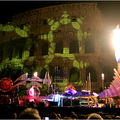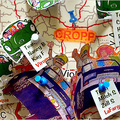An Outsider’s Camera Provides a Ticket Into a Secret World
I CAN still perfectly recall those moments, a handful of times late in my first year here in Shanghai, when the late afternoon light was at its limpid best and the very special beauty of this city seemed distilled for me in all its clarity.
There was the scene around a blackened wok in which thick sections of river fish had been freshly deposited in dancing, golden oil, drawing a hungry and animated crowd that was more interested in focusing on matters at hand than in locking in on the foreigner with the big, old-fashioned camera who was busily taking their pictures.
There was the pudgy boy taking his time with a mass of cotton candy as he clung to a street sign post, circling it now and then like a game park carousel. He eyed me more warily, probably never having seen anything like my Rolleiflex, with its bulging eye-like twin lenses. But eventually his pink snack provided just enough distraction, allowing me to get a shot that even now feels like a ticket into a secret world.
There was the grizzled man in the wool cap and greatcoat, perfectly still, with one foot perched on his bicycle cart stacked high with mushrooms. He had parked his cart smack dab in the middle of the street, as if he were holding the line against the encroachments of a new and unwelcome kind of lifestyle: one built around honking automobiles and fluorescent-lit supermarkets.
All three of these scenes were shot on a street so obscure that I found most taxi drivers needed directions to get there. It is not that the neighborhood is so far from the center of the city. It is not. Rather, Shanxi Road, just north of Suzhou Creek, had been more or less spared the unsparing onslaught of demolishing crews that precedes the breakneck redevelopment of this city, making it a very special, if neglected place.
Standing in the middle of Shanxi Road along with its salt-of-the-earth traders in those early days couldn’t have been more of a revelation for me than if I had I stepped into a time machine and strapped myself in for a journey. Here was a slice of that increasingly rare thing in China, indeed anywhere — the authentic.
Neighborhoods like these, and the city that was built from them, were Shanghai’s unique contribution to a culture whose experience of cities was long and distinguished, going back at least 3,700 years, but which had nonetheless never seen anything like this before.
Other large Chinese cities had in fact always been more like oversize villages; the greatest of them, Beijing, being a gigantic imperial village. But Shanghai, a precocious forerunner of today’s globalization, with its influx a century ago of bankers and industrialists from the world over, was new and different. And byways like Shanxi Road with their busy grid layouts, their European-influenced housing of two-story walk-ups, their internal courtyards and endless alleyways were built to accommodate a new kind of lifestyle created for and by millions of migrants drawn by the novelty of cash-paying jobs in factories.
My love of Shanxi Road gradually led me toward other discoveries, and over the last three years, I have come to relish nothing more than finding these unspoiled outposts of the past in the middle of Shanghai’s ever thickening forest of skyscrapers and losing myself in them for hours at a time, camera in hand.
None of the neighborhoods that I began to plunge into were truly hidden. Rather, they lived on in their quiet timeless way, wholly unsuspected from just a block or two away, obscured as it were by flashy new neighborhoods composed of jostling tall structures or roped off by looping expressways. I stumbled upon one after a stroll down Huai Hai Road, one of Shanghai’s great modern shopping boulevards. The telltale sign of traditional black Chinese-style roof tiles, just barely visible, lured me down a narrow, gently winding side street, which I followed for a short distance until it spilled onto a larger street, which took my breath away.
This street, Fangbang Road, in all of its slightly shabby glory, became one of the centers of my photographic world over the next two years, drawing me back again and again, as surely as I was pulled along that late afternoon that fall day by the swift current of foot traffic of people returning home in time for an early dinner. Busier by a good measure than Shanxi Road, with small shops open to the street on the ground floor of just about every building — a fish monger chopping up his catch here, a poultry dealer depluming chickens for a customer by dunking them in scalding water there, the incessant beckoning cry of the fresh fruit and vegetables ladies — it took me a while to catch the rhythm of this place.
Eventually, though, I learned to isolate people taking a break from the bustle, and now and then I managed to freeze, as it were, those moments of absolute calm.
One of the most pleasurable of these moments happened as I came upon a shirtless young boy on a stultifying summer afternoon. He sat on the curb in front of his empty bicycle cart, having sold or delivered its cargo and wearing a look of deep fatigue.
Another day on that same street in that same season I happened upon a family at dinner, their chairs and table in the street. As I crept closer, the boy was being scolded by his mother — ostensibly about not finishing his dinner. I knelt on one knee and quietly took the shot, feeling like a privileged guest at the most intimate of rituals.
To walk these streets is to get a skewed impression of Chinese demographics. Old people are everywhere, and they form an undeniable part of the character of these places, with etched faces that speak of all the unspeakable travails of China’s modern history. With the areas I have focused on — all fast coming under the assault of bulldozers — the gazes of the elderly often seem to convey their deep sense of uncertainty, anxiety even, as the tightly knit neighborhoods where they have spent their lives are plowed under and they are moved to unfamiliar settings on the outskirts of town for the difficult climb of making a new life.
These looks, seen over and over, inevitably raise the question of how Shanghai’s people feel about the extraordinary urban redevelopment process that is under way. For the most part, they have never been asked, certainly not by the government, which executes its grand designs by fiat.
The answer, in fact, is not a simple one. Shanghai’s fast-disappearing old quarters drip with charm, but they are also full of problems, from cramped living spaces that have been subdivided over the years to inadequate heating and plumbing.
Many who can afford to move into the high-rises sprouting up everywhere are happy to do so. Others wear looks of mourning.
Over and over again, I have been asked by the people of these neighborhoods what is my purpose in taking pictures of these lives? Am I trying to show a bad side of China? To make fun of poor people?
I have no trouble answering, and my reply is effective more often than not because it is sincere. “I take pictures in your neighborhood because there is something very beautiful about the lifestyle you have,” I say. “Things may not be perfect, but there is a very special kind of community you have, and soon places like this will all be gone.”






